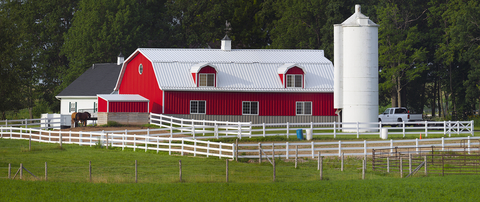Quick facts
- Design pastures that meet your farm’s needs and are safe for both you and your horse.
- Avoid placing pastures in wet areas or on steeply sloping hills.
- Two acres of pasture for each grazing horse will reduce the dependency on hay during the growing season.
- Make sure your horses have free access to clean, fresh water while they are grazing.
Establishing a horse pasture takes time, patience and resources. Site planning is a key step. Planning ahead will ensure your pasture is successful and productive for years to come.
Selecting a site
Selecting appropriate pasture sites is key to productive forage and healthy horses. When selecting a site, avoid areas that include:
- Steeply sloping hillsides.
- Wetlands, ponds or creeks.
- Soil types that vary greatly.
- Pastures that are placed up and down hillsides.
- Dense woods.
While no pasture is perfect, try to find a relatively flat, fertile area to establish your pasture. Be mindful of trees or shrubs you decide to include in your pasture. Chokecherry, boxelder and red maple are a few of the common trees that have seeds, leaves or other plant parts that are poisonous to horses.
Plants that can be harmful in the pasture are listed on our main horse pastures and facilites page.
Keep horses out of rivers, creeks, swamps and wetlands. Horses can cause environmental damage such as soil erosion from overgrazing or water pollution from manure and runoff. In addition, wet areas are usually home to biting flies, mosquitoes and poisonous plants.
Sizing your pasture
Make sure you plan a pasture that’s large enough to handle the acreage layout, grazing system and number of horses you have per acre of pasture (stocking rate).
- Pastures can usually provide enough forage for one horse for every two acres during the grazing season. Soil type, grazing practices and weather can all affect how many horses a pasture area can support.
- Rectangular pastures encourage horses to exercise. Irregular-shaped pastures can limit exercise and increase a horse’s risk of injury.
- Pastures less than one acre per horse are not ideal.
- Consider dividing large pastures into several smaller pastures to maximize grazing through rotation.
Planning a dry lot
- Dry lots, or sacrifice paddocks, provide an opportunity to move horses off the pasture during wet or dry conditions or when pastures need rest.
- Dry lots vary in size but should provide at least 400 square feet per horse.
- Dry lots usually include shelter, water and space to feed hay.
- See Horse dry lots and shelters for more information.
Placing dry lots next to pastures or using laneways can allow horses access to the dry lot’s shelter and water during grazing.
Placing gates and choosing fencing
Always place gates in the corners that are closest to the direction the horse or you will be traveling. Avoid placing gates in low areas where water may pool and cause mud. Pasture gates should be large enough for several horses to go through but also for equipment such as a tractor, drag or mower. Select gates that you can easily open with a single hand so you can safely and securely hold your horse with the other.
When choosing a fencing system, consider your budget as well as the appearance, safety, installing process and containment of the fence. Remember, the main purpose of a fence is containment. See Horse fencing considerations for more information.
Water
Horses need free access to clean, fresh water. Place waterers and troughs in areas where filling and cleaning are easy. If possible place water sources where multiple pastures will have access to them. Using laneways and gates to provide access to dry lot waterers from the pastures can be an effective approach. In addition, avoid placing water sources under trees where leaves and seeds may become a problem.
Reviewed in 2023



